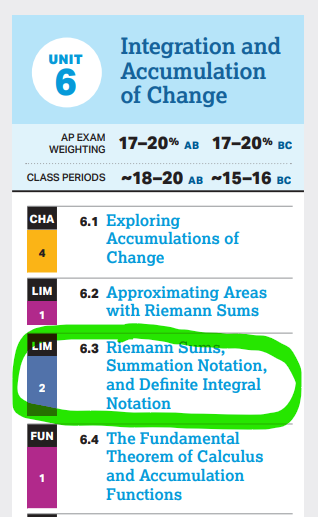The FINAL AP Calculus lesson: Sigma <--> Integral notation
It’s almost time… there are only TWO SCHOOL DAYS LEFT until the AP exam. It is an exciting, nerve-wracking, and hectic time, and my seniors have been putting in lots of hours after school this week finishing up their AP Calculus mock exam revisions this week while also preparing for and taking their other AP exams.
So we ‘finished’ polar in class this week. I say ‘finished’ because although we covered everything and did practice problems on each skill, ideally we would have done many more types of challenging problems. Nevertheless, they know the formulas and have been thinking about polar for a week straight. That means it’s time for the FINAL TOPIC that I save for the very end of the class: summation notation and integral notation!
CollegeBoard has this skill listed at the beginning of Unit 6 in their curriculum guide:
To be clear, we do cover limit summation notation and how mathematicians replaced the ‘limit sigma’ with ‘integral,’ an elongated S to represent the Greek letter S, which is Sigma. S for SUM since you’re adding all the infinitely many terms up. However, we do NOT get into the details of exactly how to rewrite and convert from one to the other. This skill used to intimidate me because it is very notation-heavy, but once I found this graphic novel from the Math Teacher Mambo blog (which was once very active around 2016 but ended in 2019) it all clicked in my mind. Shireen, the creator of the blog, has a skill with creating beautiful, funny, sometimes cheesy, but well-laid out graphic organizers. This one is simple and has never failed to quickly show my students how to convert from one form to the other. PDF version HERE.
When I make copies, I use the ‘2 in 1’ feature to copy both pages onto one standard 8.5”x11” sheet of paper, and then I paper cut them so they have two smaller sheets to tape into their notebooks. I am a huge proponent of taping everything into the notebook rather than handing out worksheets. The worksheets get stuffed into a folder, disorganized, and probably lost. If it gets taped in, it will stay there, in order, for easy reference. Here are my answers to the four problems at the end:
Next, we go through several multiple choice questions from former AP exams and from the AP classroom question bank. I created a Jamboard with a bunch of these, but since Jamboard is ending this year (such tragic news), I am posting the PDF file of problems HERE.
As we go through these, I point out that if a question like this appears on the exam, they can expect it to be at the very end of the non-calculator section. Typically, it has been question #30, the final question.
The last thing we do is this CIRCUIT written by Mark Kiraly, which is free on his Teachers Pay Teachers account.
This circuit is challenging and is not one that I could do half-asleep or partly paying attention. I got lost the first time I attempted it and had to start all over, so if you use it in your classes, make sure you do it fully on your own first! It really is a terrible feeling to admit to your students you have no idea what to do on a problem!




